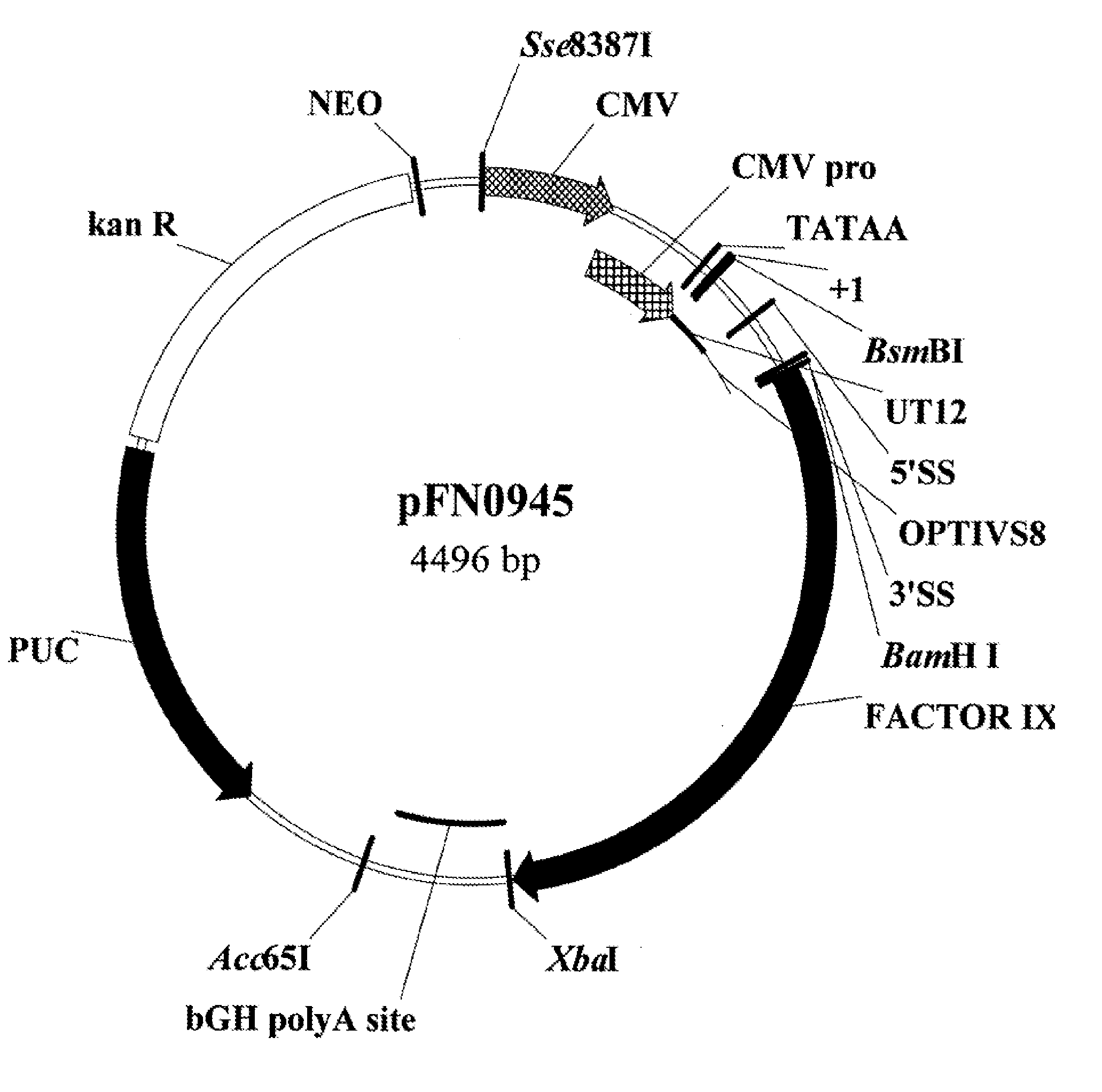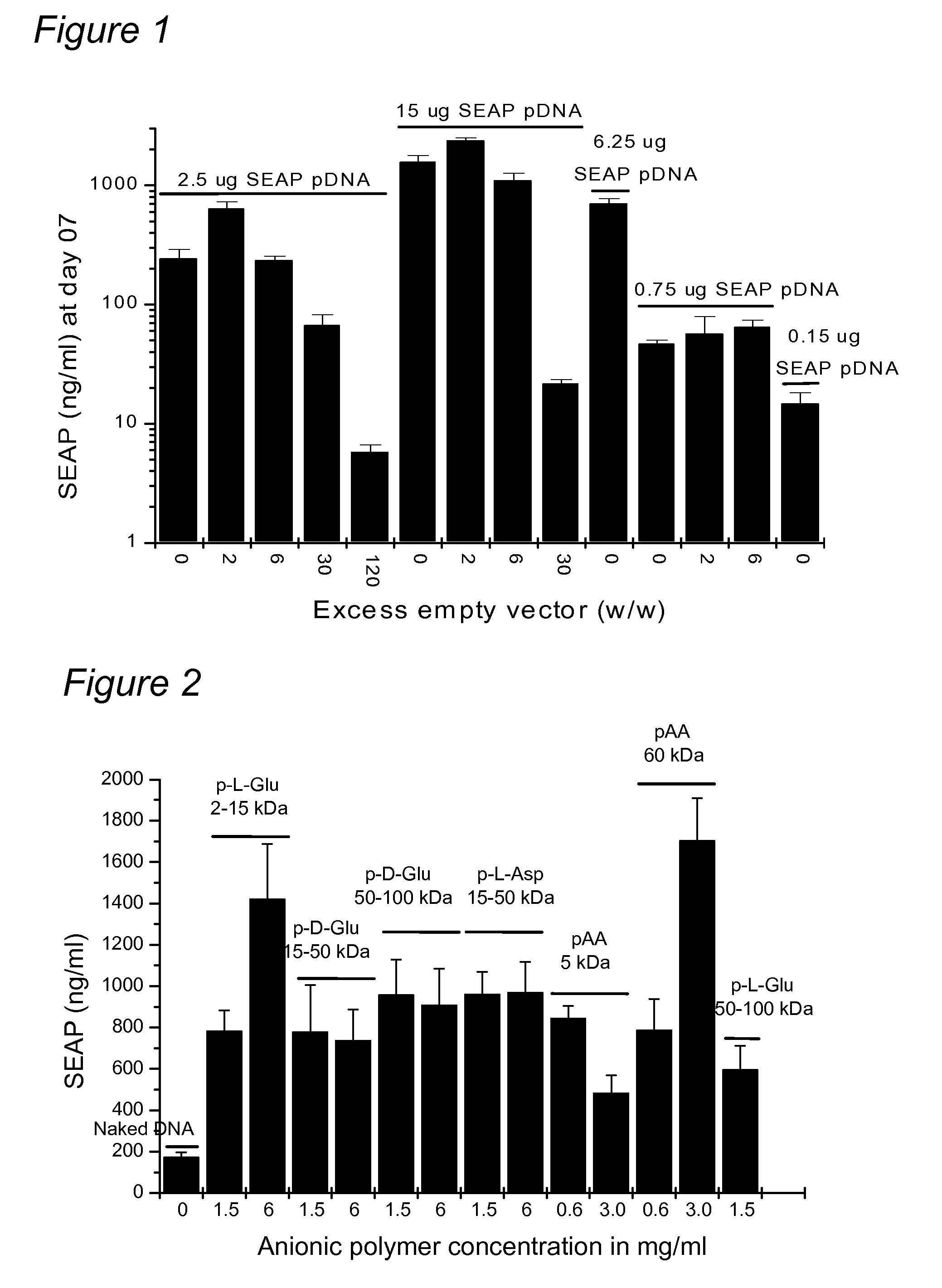Nucleic Acid Formulations for Gene Delivery and Methods of Use
a technology of nucleic acid and gene, applied in the direction of non-active genetic ingredients, peptides, drug compositions, etc., can solve the problems of inability to re-administration with these vectors, limitations of viral-based approaches, and debilitating destruction of patients' joints, etc., to prolong the localized bioavailability of nucleic acid and enhance expression
- Summary
- Abstract
- Description
- Claims
- Application Information
AI Technical Summary
Benefits of technology
Problems solved by technology
Method used
Image
Examples
examples
[0089] The following examples are offered by way of illustration and are not intended to limit the scope of the invention in any manner. One of ordinary skill in the art would recognize that the various molecules and / or amounts disclosed in the examples could be adjusted or substituted. It would also be recognized that the delivery targets and / or amounts delivered in the examples could be adjusted or substituted by selecting different muscles for injection, injection into tumors or nodes, or increasing or decreasing the duration of pulse time or alternating the pulse application from pre-injection to post-injection.
Preparation of Formulations
[0090] Formulations were made by aliquoting appropriate volumes of sterile stock solutions of water, plasmid, polymer, buffer and / or 5M NaCl to obtain a final plasmid in an isotonic solution. The total plasmid concentration of all formulations was measured by UV absorption at 260 nm. The osmotic pressure of selected formulations was measured ...
example i
Determination of Formulation and Delivery Parameters Using Reporter Genes
[0111] Formulating DNA with anionic polymers increases electroporation-mediated gene expression after an intra-muscular injection. An example of an anionic polymer is an excess of non-coding DNA, which can increase transgene expression. The protocol that was regularly used to transfect the myofibers of CD-1 or C57BL / 6 mice consisted of an injection of a DNA solution followed, two minutes later, by the electroporation of the injected muscle with a clamp electrode. A constant mass (0.75 micrograms, 2.5 micrograms or 15 micrograms) of a plasmid DNA coding for the SEAP (human placental secreted alkaline phosphatase) gene with various amounts of an empty plasmid was co-injected in the tibialis cranialis muscle of CD-1 mice. Empty plasmid means that the plasmid does not carry the coding sequences for SEAP or, preferably, any other gene.
[0112]FIG. 1 shows SEAP serum concentrations at day 7 post injection of SEAP pDN...
example ii
Determination of Reporter Gene Expression Using Poly-Glutamic Acid without Electroporation
[0123] In order to determine the ability of sodium poly-glutamate to increase the expression of genes encoded on plasmid DNA without electroporation, plasmid DNA formulated in saline was compared with a formulation in sodium poly-glutamate for expression after direct intramyocardial injection in mice.
[0124] Plasmid DNA encoding luciferase (pLC0888) was formulated in saline or 6% sodium poly-L-glutamate ((Sigma P4636) at plasmid concentrations of 1 and 3 mg / mL. A total of twenty CD-1 male mice (29-31g) were used. The myocardium was injected directly after surgical exposure. Ten (10) microliters of formulation (using a 3 / 10 cc insulin syringe) were injected into the apex of the heart (i.e., left ventricle). The heart was repositioned and the thorax sutured. Seven days after injection, the hearts were removed and snap frozen in liquid nitrogen, and stored at −80° C. until needed for analysis. Fo...
PUM
| Property | Measurement | Unit |
|---|---|---|
| molecular weight | aaaaa | aaaaa |
| molecular weight | aaaaa | aaaaa |
| molecular weight | aaaaa | aaaaa |
Abstract
Description
Claims
Application Information
 Login to View More
Login to View More - R&D
- Intellectual Property
- Life Sciences
- Materials
- Tech Scout
- Unparalleled Data Quality
- Higher Quality Content
- 60% Fewer Hallucinations
Browse by: Latest US Patents, China's latest patents, Technical Efficacy Thesaurus, Application Domain, Technology Topic, Popular Technical Reports.
© 2025 PatSnap. All rights reserved.Legal|Privacy policy|Modern Slavery Act Transparency Statement|Sitemap|About US| Contact US: help@patsnap.com



